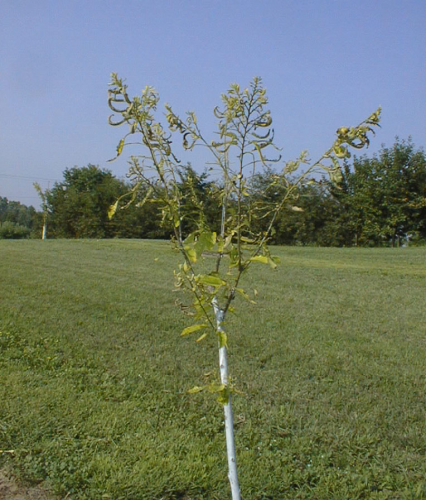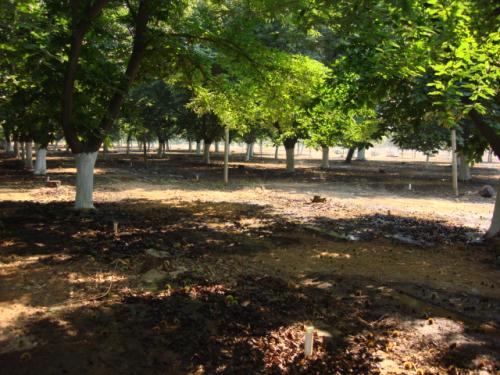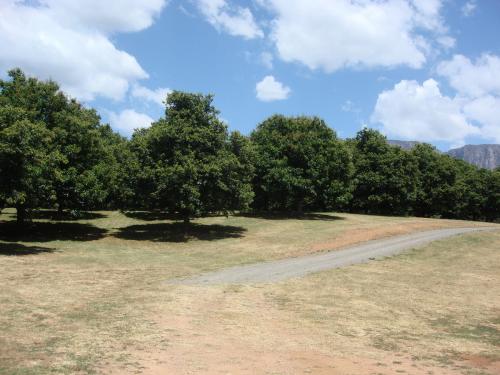Orchard Design & Establishment
Site preparation
Many factors determine the suitability of a site for chestnut production. A good, well-drained, relatively fertile soil is most desirable. Soil types, drainage, texture, and the amount of organic matter in Michigan soils can vary markedly even within a small area. The importance of a careful soil survey prior to planting cannot be overemphasized as this may help to prevent mistakes that the grower will have to contend with for the life of the orchard.
Chestnut orchards can only be established on well-drained soils where the pH varies from 5.5 to 6.5. The pH can be lower, but it cannot go much higher without nutrient problems developing. We have seen the burning of young shoots and leaves associated with pH below 4.5. A pH above 7.0 leads to leaf chlorosis and stunted growth (Figure 1). If you cannot meet these basic features with your land, do not attempt to grow chestnut or be prepared to constantly neutralize these constraints. Soil testing and preperation should take place before trees are planted.
Planting on hills is better than on flat land. That not only provides good water drainage, but you need to consider the drainage of frost and the development of frost pockets which have a tendency to develop and harm trees on flat land. Wind damage may occur, but rarely affects production long term. In fact, wind movement on ridges may help prevent frost. Trees have a tendency to bend on windy ridges, so make sure to stake them toward the wind to prevent the permanent bending of the main trunk. As you work through the following information, growers may find this Chestnut orchard design fact sheet helpful.


Most soil nutrition problems can be solved with soil and tissue analysis. Some would add micronutrients, but here the plant on the left needs to have its soil pH adjusted first. The chlorotic weakened planted on your left is more susceptible to attack by insects. The plant on the right is healthy.
Planting
Chestnut trees typically ship as potted trees in September and are planted in the fall. Trees should be irrigated and kept moist through the early part of fall if it is dry. It is important to carefully note the location of all the cultivars in the field at planting, tree tags disappear and memories fail.
Tree holes should be large enough to accommodate the root system with a minimum of root pruning. However, long roots can be cut back enough to balance the root system and to allow planting without crowding or twisting roots to get them into the hole. If an auger is used in wet, clay soil, the inside surface of the hole glazes and seals off, sometimes preventing root penetration. It also leads to the possibility of rain or irrigation water saturating the soil in the hole and not draining out creating a condition of low oxygen. This undesirable glazing of holes can be prevented by digging the holes a few days ahead of planting, when the soil is dry or with low moisture. If this is not practical, part of the glaze can be removed by slicing the edges with a shovel at planting time.
Bare-rooted plant roots should be kept in water or be kept moist prior to planting, and, unless the soil is wet, the tree should be watered at planting. Do not put chemical fertilizers in the hole at planting time because the roots can be killed by such treatment. Be sure to plan for adequate weed control after planting so the young trees can effectively scavenge for water and nutrients without competition.
The final consideration in planting trees is the planting depth. Dig planting holes 2 to 3 times wider than the root ball and the same depth. Place the root ball on solid soil and not loose backfill. The graft union should be above the soil line. A properly planted tree will be more tolerant of adverse conditions and require much less management than one planted in-correctly. Planting technique impacts water quality as it minimizes water, fertilizer, and pesticide use.
Fall chestnut planting in Michigan, with cover crop in tractor row. Note the mouse guards and deer repellent saches.
Potted trees can be planted from mid-September to mid-October as the usually cool temperatures and adequate rainfall make autumn a good time to plant trees. Consider the soil may be warmer and less damp than in the spring. Fall-planted trees will demand extra attention, because these trees may not have enough time to establish a good root system before winter sets in. Cold winter winds and sunshine cause plants to lose water from their branches, so roots need to be well established to replace the water if trees are to survive. Water plants thoroughly and when needed supply about 1 inch of water per week. Continue watering until the ground is frozen. Wrap the trunks with the plastic mouse-guards (tree-guards) by late November to prevent frost, sunscald, and animal damage. Be sure to remove and reset the tree-guard sometime after April so it does not girdle the trees.
You may expect to lose 2-10 percent of a new planting. Just as there are good growing and yielding seasons, there are also good planting seasons and bad planting seasons so mortality may naturally approach 10% some seasons. Droughts, heat, cold, insects, and deer take their toll. A 2-4 inch layer of mulch can help prevent wide soil temperature fluctuations. Apply materials such as shredded bark, pine straw, or typical wood chips in late November, after the plants are fully dormant and the soil is cold. If fall planting is extended into November and December, root growth may be poor and planting failures will probably occur. In summary, fall planting (mid-August to mid-October) takes advantage of favorable soil temperatures and moisture conditions that promote the root growth needed to sustain plants through their critical first year in the orchard. Watch the brief video below to see some tricks and tips on planting!
Cultivars and layout
A diverse selection of cultivars should be planted to ensure adequate pollination and mitigate risks associated with monoculture production. For commercial production, the two most popular primary bearing cultivars are ‘Colossal’ and ‘Bouche de Betizac’, both of which are pollen sterile. The two most common pollinizer cultivars are ‘Precoce Migoule’ and ‘Labor Day’ which are also able to pollenize each other as well as 'Colossal' and 'Bouche de Betizac'. Some growers are also mixing in multi-use cultivars like ‘Maraval’, ‘Marsol’, and ‘Marigoule’ which show promise as nut bearers, pollinizers, and timber trees. In terms of orchard planning, ‘Maraval’, ‘Marsol’, and ‘Marigoule’ should be treated as pollinizers in the layout of trees. Chinese chestnuts should never be planted with European X Japanese hybrids as a pollen incompatibility occurs.
There are a number of considerations when laying out a chestnut orchard, but the most important consideration is wind direction. Chestnut trees are wind pollinated, requiring the layout ensure that pollinizer trees be placed upwind from the primary bearing (pollen sterile) trees. Pollinizers should be interplanted to ensure they too are able to receive adequate pollen as they are not self-fertile.

Basic orchard layout to ensure pollination, given 30-foot spacing and prevailing wind direction.
Spacing
Trees planted too close eventually develop poor health and undesirable shapes. As crowding occurs, nut production and quality will be reduced. Growers are encouraged to consider planting trees 25-30 feet apart to avoid crowding and tree removal, but ensure adequate pollination. This wider spacing will mean fewer nuts during the early years of the orchard, but will avoid the expense of tree removal or losses due to shading and competition.

Branch death occurs as the trees grow into each other in a 'Colossal' orchard in California.

Grower begins to remove trees in orchard, attempting to get more light to the trees.

In comparison, this 20-year-old chestnut orchard composed of similar trees (grafted European X Japanese hybrids) in Australia is what growers in Michigan should strive for. You can see the large trees, but each tree casts its own shadow indicating that sunlight lands on the entire surface area of the tree. That’s important because that is where the flowers are borne. Only the internal branches of these trees are shaded, where flowers are not produced.
|
Trees per acre based on tractor row width and tree spacing |
||
| Tractor row width (ft.) | Tree spacing (ft.) | Trees per acre |
|
30 |
30 | 48 |
|
25 |
25 | 70 |
| 30 | 20 | 73 |
| 20 | 20 | 109 |
The number of trees per acre planted different distances in the row and between rows.
Tree care
Mouse/Tree Guards: Tree or mouse guards look like it has a spring-like coil that protects the lower 2-3 feet of small diameter trees from rodent girdling. Tree guards should be removed each spring and redeployed each fall. If left on the tree, tree or mouse guards can cause severe damage to the trunk of the tree as they do not expand with the trunk.
Preventing Sunscald: Chestnut trees are susceptible to an injury called "sunscald" during the winter and early spring. Sunscald occurs when the surface temperature on the bark of trees is elevated above that of the surrounding air by the absorption of sunlight. This rise in surface temperature occurs long enough to make cells in the bark active and thus vulnerable to injury during the sudden nighttime temperature drop. Growers are advised to paint their trees with a white latex paint diluted 50% with water. The white paint helps reflect the sunlight and keep the surface temperature of the trunk lower. It can be painted on with a brush or sprayed on the tree and should be reapplied as needed.
Intercropping
Establishing a chestnut orchard takes time, and the wide spacing between trees might lead growers to consider intercropping as a mean of utilizing unproductive ground as trees become established. Growers should carefully consider crop characteristics, particularly any potential negative effects including drawing pests, incompatible pesticide applications, equipment compaction, soil degradation, etc. Watch the brief video below of one example of intercropping.



 Print
Print Email
Email